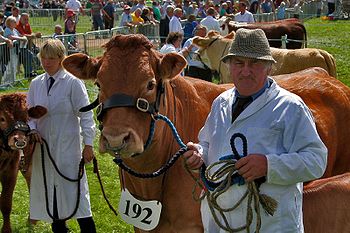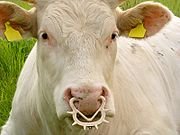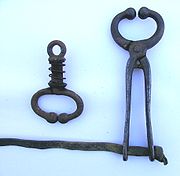.gif)
Nose ring (animals)
Encyclopedia

Bull
Bull usually refers to an uncastrated adult male bovine.Bull may also refer to:-Entertainment:* Bull , an original show on the TNT Network* "Bull" , an episode of television series CSI: Crime Scene Investigation...
s. Nose rings are often required for bulls when exhibited at agricultural shows. There also is a clip-on ring design used for controlling other cattle for showing or handling. Nose rings are also used to prevent pig
Pig
A pig is any of the animals in the genus Sus, within the Suidae family of even-toed ungulates. Pigs include the domestic pig, its ancestor the wild boar, and several other wild relatives...
s rooting, and to encourage the weaning of young calves
Calf
Calves are the young of domestic cattle. Calves are reared to become adult cattle, or are slaughtered for their meat, called veal.-Terminology:...
and other livestock by discouraging them from suckling.
History and purpose
Historically, the use of nose rings for controlling animals dates to the dawn of recorded civilization. They were used in ancient SumerSumer
Sumer was a civilization and historical region in southern Mesopotamia, modern Iraq during the Chalcolithic and Early Bronze Age....
and are seen on the Standard of Ur
Standard of Ur
The Standard of Ur is a Sumerian artifact excavated from what had been the Royal Cemetery in the ancient city of Ur .-History:...
, where they were used on both draught cattle and equines
Equidae
Equidae is the taxonomic family of horses and related animals, including the extant horses, donkeys, and zebras, and many other species known only from fossils. All extant species are in the genus Equus...
.
It is estimated that 42% of all livestock-related fatalities are a result of bull attacks, and only about one in twenty victims of a bull attack survives. Dairy breed bulls are particularly dangerous and unpredictable; the hazards of bull handling are a significant cause of injury and death for dairy farmers in some parts of the United States.
Use
The nose ring assists the handler to control a dangerous animal with minimal risk of injury or disruption by exerting stress on one of the most sensitive parts of the animal, the nose. Bulls, especially, are powerful and sometimes unpredictable animals which, if uncontrolled, can kill or severely injure a human handler.Control of the bull may be done by holding the ring by hand, looping a piece of rope through it, clipping on a lead rope, or clipping on a stiff bull pole (bull staff). A rope or chain from the ring may be attached to a bull's horns or to a head-collar for additional control.
With an aggressive bull, a short length of chain or rope may be left hanging loose from the ring, so when he ducks in a threatening manner, the bull will step on the chain and be deterred from attacking. This lead may also facilitate capture and control of a frisky bull.
Construction and insertion
Bull rings are usually about 3 to 5 in (7.6 to 12.7 cm) in diameter, depending on the size of the bull. Bull rings are commonly made from aluminum, stainless steel or copper, in the form of a pair of hinged semicircles, held closed by a small brassBrass
Brass is an alloy of copper and zinc; the proportions of zinc and copper can be varied to create a range of brasses with varying properties.In comparison, bronze is principally an alloy of copper and tin...
bolt whose head is broken off during installation. If a ring needs to be removed (for example, if the bull has grown out of it), it is cut or unscrewed.
The ring is normally placed on the bull between 9 to 12 months of age. It is usually done by a veterinarian
Veterinarian
A veterinary physician, colloquially called a vet, shortened from veterinarian or veterinary surgeon , is a professional who treats disease, disorder and injury in animals....
, who pierces the septum with a scalpel
Scalpel
A scalpel, or lancet, is a small and extremely sharp bladed instrument used for surgery, anatomical dissection, and various arts and crafts . Scalpels may be single-use disposable or re-usable. Re-usable scalpels can have attached, resharpenable blades or, more commonly, non-attached, replaceable...
or punch. Self-piercing rings (with sharp ends designed to be pressed through the septum and then pulled together with a screw) have been available for many years; these are also usually installed by a veterinarian rather than the farmer.
Calf-weaning ring
Calf-weaning nose rings or nosebands provide an alternative to separating calves from their mothers during the weaning period. They have plastic spikes which are uncomfortable for the cow, causing her to reject the calf's efforts at suckling. Weaning nose rings are also available for sheep and goats. These nose rings (usually made of plastic) clip onto the nose without piercing it, and are reusable.
Bulldogs
Self-locking or spring-closing show-lead nose rings, also called "bulldogs" or nose grips, are removable rings that do not require the nose to be pierced. They are often used on steers and cows, along with a halter, at agricultural showAgricultural show
An agricultural show is a public event showcasing the equipment, animals, sports and recreation associated with agriculture and animal husbandry. The largest comprise a livestock show , a trade fair, competitions, and entertainment...
s, or when handling cattle for examination, marking or treatment. They stay shut until released, and usually have a loop for the attachment of a cord or lead rope. They give similar control to a bull ring without the need for permanent installation.

Bull tongs
Bull-holders, also known as bull-tongs, have a pliers action and are used for short periods on grown cattle when they are being mouthedCattle age determination
The age of cattle is determined chiefly by examination of the teeth, and less perfectly by the horn rings or the length of the tail brush.-Teeth method:...
or drenched. A chain, rope or strap keeps the grips closed and may be passed over a bar at the front of a head bail to elevate the head. The thumb and forefinger may also used in this way on smaller animals.
Pig rings
PigPig
A pig is any of the animals in the genus Sus, within the Suidae family of even-toed ungulates. Pigs include the domestic pig, its ancestor the wild boar, and several other wild relatives...
s dig or "root" with their snouts, and such digging may be undesirable in some circumstances. Nose rings make digging uncomfortable for the animal, although a rung pig is still able to forage freely through leaf litter and surface vegetation. Pig ringing may sometimes be required by local regulations, as when pigs are turned out for pannage
Pannage
Pannage is the practice of turning out domestic pigs in a wood or forest, in order that they may feed on fallen acorns, beechmast, chestnuts or other nuts. Historically, it was a right or privilege granted to local people on common land or in royal forests...
in public woods (such as on the New Forest
New Forest
The New Forest is an area of southern England which includes the largest remaining tracts of unenclosed pasture land, heathland and forest in the heavily-populated south east of England. It covers south-west Hampshire and extends into south-east Wiltshire....
in southern England
England
England is a country that is part of the United Kingdom. It shares land borders with Scotland to the north and Wales to the west; the Irish Sea is to the north west, the Celtic Sea to the south west, with the North Sea to the east and the English Channel to the south separating it from continental...
).
Pig rings usually consist of open copper wire rings with sharp ends, about one inch (about 2.5 cm) in diameter. These are clipped to the rim of the nose, not through the nostrils. Typically an adult pig will be given three or four rings, as they may sometimes be dislodged. Alternatively a ring may be placed through the septum, similar to a bull's ring.
Bull handling in the show ring
For safety reasons, many show societies require bulls over 12 months to be led with a nose ring. A bull may be led by a rope tied through the ring, although a halterHalter
A halter, headcollar, or, less often, headstall, is headgear that is used to lead or tie up livestock and, occasionally, other animals; it fits behind the ears , and around the muzzle. To handle the animal, usually a lead rope or lead shank is attached...
(headcollar) is usually also used so as not to rely unduly on the nose ring for control. If the bull has horns, the lead rope may also be fastened around those and then passed down through the nose ring. Some shows require other cattle to be led with nose grips (bulldogs). Several methods exist for handling a bull with a ring installed. One method of leading a bull is to have one person either side of the bull with both halter lead ropes through the ring, which prevents the bull from gaining pace and also from running into the handlers. Another practice is for one handler to use a rope and the other a bull-staff attached to the ring.

Bull handling on the farm or ranch
Most cattle breeders recognize the importance of looking after expensive bulls that are expected to improve herds and profits. Nonetheless, the dangers of bull handling, particularly from dairy bulls in close quarters, are regularly proven by the obituaries. Good bull management and safety practices require caution in handling beef and dairy bulls, and use of the nose ring and chain is a recommended precaution for modern farmers.However, in many regions, particularly in the beef industry, bulls do not have nose rings unless they are to be exhibited and they are generally driven about as other cattle would be. Cows with young calves can be particularly dangerous if protecting their young, and cattle in general, including calves, steers and bullocks, do cause many serious human injuries and deaths.
Generally the use of both a ring and a halter, and management of the bull by two people, is the preferred method today for controlling the bull. Typically, a bull was led by a wooden staff with a steel end that snapped into the ring. A long rigid steel or wooden bull staff locked into the ring could also be used to push a bull out of a pen without requiring the handler to enter the pen for cleaning or feeding. Because of the risk that the bull may drive the staff into the handler if the bull misbehaves many handlers prefer to avoid their use nowadays. One current veterinary text still recommends the use of a staff in addition to the halter:
Many handlers rely on a nose ring to control a bull. But a ring in his nose is no good unless you have a bull staff and use it. A bull staff is a pole with a snap in the end that clips to the bull ring. Leading a bull with a staff gives you a lot more handling power as the bull can't get any closer to you than the length of the staff allows. Leading him only by a chain in the ring lets him run over you at will.
Most dairy or beef farms traditionally had at least one, if not several, bulls for breeding purposes. The handling of an aggressive, powerful animal was a practical issue with life-threatening consequences for the farmer. The need to move the bull in and out of its pen to cover cows exposed the farmer to serious jeopardy of life and limb. Being trampled, jammed against a wall or gored by a bull was one of the most frequent causes of death in the dairy industry prior to 1940. As suggested in one popular farming magazine, "Handle [the bull] with a staff and take no chances. The gentle bull, not the vicious one, most often kills or maims his keeper."

Tractor
A tractor is a vehicle specifically designed to deliver a high tractive effort at slow speeds, for the purposes of hauling a trailer or machinery used in agriculture or construction...
, providing both motive power and a degree of protection from the angry bull. The efficacy of this technique is doubtful, and may depend on the size of the tractor and of the bull; one authority has "seen a bull lift the front end of a tractor like a toy". Others used dogs and horses. Not all farmers could afford specially designed and manufactured bull handling products, which were not readily available until the 1980s. The experimental improvisation of techniques for bull handling, as in many aspects of family farm
Family farm
A family farm is a farm owned and operated by a family, and often passed down from generation to generation. It is the basic unit of the mostly agricultural economy of much of human history and continues to be so in developing nations...
ing, was a common practice.
See also
- Nasal septum piercing (humans)
- Animal husbandryAnimal husbandryAnimal husbandry is the agricultural practice of breeding and raising livestock.- History :Animal husbandry has been practiced for thousands of years, since the first domestication of animals....

